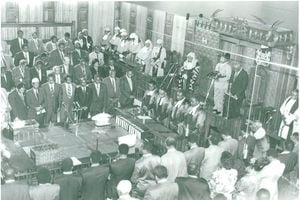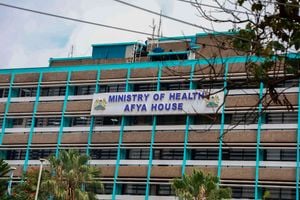
One of the critiqued sculptures.
As a matter of fundamental justice, it is imperative to enunciate the clarification that every implacable jeremiad directly or indirectly provoked by the debacle of Eldoret city's miserable attempt at civic art, albeit legitimate, is but one dimension of the institutional profile of the North Rift's most important centre.
By all accounts, therefore, it is fair to presume that additional facets of immense interest exist, and that they amply reward interest and analysis.
To begin with, Eldoret, perhaps even more than its counterparts Nakuru farther south and Kitale a little up north, equally nested within bustling farming communities which maintain Kenya's bread basket catchment zones, has emerged as a dependable barometer of the state of our nation's agricultural sector.
Only a couple of decades ago, semi-literate octogenarians would, after patiently conducting their trucks through the kilometres-long queues to deliver maize or wheat at the National Cereals' depot, collect their cheques and proceed to various downtown showrooms, where they would take delivery of new tractors, harvesters and assorted vehicles.
Thereafter, they would cause memorable scenes as they went about their Christmas shopping and proceeded back to the villages, leaving their youthful scions to prosecute the nocturnal segment of urban adventures and associated proceedings in various subterranean discotheques.
This cohort of feisty countrymen appears to have dwindled rapidly, possibly owing to natural causes, inexorable generational dynamics and other socioeconomic factors, including steadily diminishing returns to farming due to low prices, onerous delays in paying for deliveries, vicious under-pricing by the notoriously voracious middleman, and the speedy fragmentation of landholdings on account of haphazard sale and subdivision as a consequence of inheritance.
The collapse of the agricultural economy inflicted innumerable privations on famously proud, hard-working and generally self-sufficient farming folk.
Many households resorted to disposing parcels of their farmland to meet diverse needs, ranging from basic subsistence, medical costs, the education of schoolgoing youngsters and the dignified conduct of social functions in keeping with the standard and status to which they had become accustomed in better times.
Land therefore replaced milk, beef, maize and wheat as the primary good on which many a family relied to remain afloat in hard times.
It was inevitable that the title deed would become preferred currency in many transactions, or that a predacious ecosystem of shylocks and fraudsters would evolve to spirit these instruments from the custody and possession of their true owners by means foul and fair, or that an epidemic of deceptive and secretive but nonetheless ruthless dispossession would devour the land, and that, in conjunction with other socioeconomic dynamics, transform Eldoret and Uasin Gishu beyond recognition within a decade.
One of the more disheartening facts in this lugubrious chronicle relates to the countless tracts of land given up by families to provide treatment for loved ones, either through shylocks in return for a little money or directly to hospital accountants as security for settlement of due sums.
With no guarantees of recovery forthcoming, the alienation of these properties, in the final analysis, only served as distressing monuments to desperate love.
This could be one reason why the Moi Teaching and Referral Hospital is regarded by the residents of Uasin Gishu with intense pride and ferocious sense of ownership.
In their own way, the people have paid a king's ransom for a competently run large medical facility that provides a high standard of affordable medical care, where they can comfortably take loved ones to the care of capable professionals.
The MTRH or ‘Referral', as it is popularly known, has proven largely robust to devastating bouts of toxic parochialism and the myopic embrace of self-destructive practices which, sadly, took my alma mater, Moi University, for example, to its knees.
Possibly more illustrious is the Eldoret Water and Sanitation Company which, from its fledgling days, instituted robust systems, adopted exemplary standards and consistently pursued improvements in service delivery.
Eldoret is one of the few - possibly the only, if we are to be honest - place(s) in Kenya without a proliferation of tankers hawking illegally abstracted water at exorbitant prices, and where bottled water brands struggle against the Chebara brand, available at the tap, and proudly preferred by residents to premium brands.
The secret behind this extraordinary excellence is that Eldowas complemented their commitment to high standards with what was then called total quality management.
As a matter of fact, they were the pioneers of quality management systems in their neck of the woods, bagging their ISO certification a full decade before it became all the rage.
The point is that the public neither knows, nor indeed need know, complex details of institutional operations, or granular minutiae of organisational processes.
Rather, it is finely attuned to the manifestation of every dimension of institutional quality in their totality as experienced through the goods and services produced. Welcome to Eldoret: drink tap water if you are thirsty, and do not hesitate to rush to the Referral's Casualty or Outpatient if unwell, but under no circumstance shall you expect aesthetically gratifying art from the county government.
The writer is an advocate of the High Court of Kenya










